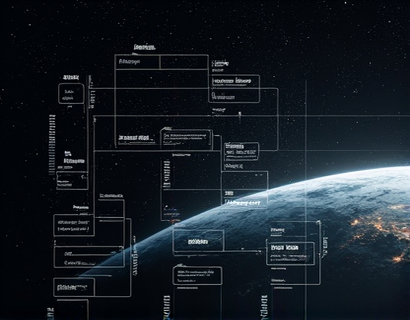Decentralized DAO Management: Transforming Governance with Advanced Analytics and Collaboration Tools
In the rapidly evolving landscape of decentralized finance and autonomous organizations, the role of governance has become increasingly complex and critical. Decentralized Autonomous Organizations (DAOs) represent a novel approach to governance, leveraging blockchain technology to create transparent, community-driven entities. However, managing a DAO effectively requires robust tools and strategies to handle the intricacies of decentralized decision-making. This article delves into how advanced software solutions can transform DAO governance by integrating advanced analytics and collaboration tools, thereby enhancing transparency, efficiency, and sustainability.
The Need for Advanced Governance Tools in DAOs
DAOs operate on a unique model where decisions are made collectively by token holders, often through on-chain voting mechanisms. While this approach promotes decentralization and community involvement, it also introduces significant challenges. Managing a DAO involves coordinating diverse stakeholders, ensuring compliance with protocols, and making data-driven decisions. Traditional governance methods are often inadequate for the scale and complexity of DAOs, necessitating advanced tools to streamline processes and provide deeper insights.
The primary challenges in DAO governance include ensuring transparency, facilitating effective communication, and enabling informed decision-making. Transparency is crucial for building trust among members and maintaining the integrity of the organization. However, the decentralized nature of DAOs can make it difficult to track actions, decisions, and financial transactions in real-time. Advanced governance tools address this by providing comprehensive dashboards and real-time analytics, allowing administrators to monitor the organization's status and performance continuously.
Advanced Analytics for Informed Decision-Making
One of the most significant advantages of integrating advanced analytics into DAO management is the ability to make data-driven decisions. Traditional governance relies heavily on intuition and subjective assessments, which can lead to biases and suboptimal outcomes. With advanced analytics, administrators can analyze vast amounts of data to identify trends, predict outcomes, and evaluate the impact of proposed changes.
For instance, predictive analytics can help forecast the success of new projects or the potential risks associated with certain governance proposals. By leveraging machine learning algorithms, these tools can process historical data and current metrics to provide insights that guide strategic planning. This not only enhances the quality of decisions but also builds confidence among community members, who can see that choices are based on solid evidence rather than guesswork.
Moreover, advanced analytics can facilitate better risk management. By monitoring key performance indicators (KPIs) and setting up alerts for anomalies, administrators can proactively address issues before they escalate. This proactive approach is essential in a decentralized environment where delays in response can have significant consequences.
Enhancing Collaboration Through Advanced Tools
Collaboration is the lifeblood of any DAO, and advanced tools can significantly improve how members work together. Communication is a critical aspect of governance, and traditional methods such as email threads and forum posts can become cumbersome and disorganized. Advanced collaboration platforms offer structured ways to manage discussions, track progress, and ensure that all relevant parties are informed and engaged.
These platforms often include features like task management, document sharing, and real-time chat. Task management tools allow administrators to assign responsibilities, set deadlines, and monitor progress, ensuring that projects move forward efficiently. Document sharing ensures that all members have access to the latest information and can contribute to ongoing discussions. Real-time chat facilitates immediate communication, reducing the lag time associated with traditional methods.
Another important feature is the integration of voting and proposal management systems. These tools streamline the process of submitting, discussing, and voting on governance proposals. By providing clear timelines, transparent voting mechanisms, and detailed analytics on vote outcomes, these systems help maintain fairness and accountability. Members can easily track the status of proposals, view discussion logs, and understand the reasoning behind final decisions.
Building a Culture of Transparency
Transparency is a cornerstone of successful DAO governance. Advanced governance tools enhance transparency by providing real-time visibility into the organization's activities and financial health. Dashboards that display key metrics such as token distribution, revenue streams, and expenditure patterns allow members to stay informed and engaged.
Blockchain's inherent transparency is a double-edged sword; while it ensures that all transactions are recorded and verifiable, it can also lead to information overload. Advanced tools help filter and present this data in an accessible and understandable format. For example, interactive charts and graphs can visualize financial flows and project progress, making it easier for members to grasp complex information at a glance.
Furthermore, transparency extends to the governance process itself. Tools that log and archive all discussions, votes, and decisions create a comprehensive history that is accessible to all members. This not only builds trust but also holds administrators accountable, as their actions and decisions are recorded and can be reviewed at any time.
Fostering Community Engagement and Participation
Engaging the community is vital for the success of any DAO. Advanced collaboration tools can help foster a sense of ownership and participation among members. By providing easy-to-use interfaces and intuitive features, these tools encourage more members to get involved in governance processes.
For example, gamification elements such as badges, points, and leaderboards can motivate members to participate in discussions and voting. These incentives create a positive feedback loop, encouraging active engagement and contributing to a more vibrant and dynamic community.
Additionally, advanced tools can facilitate the formation of working groups and committees focused on specific initiatives. These sub-communities can collaborate more effectively, leveraging the tools to coordinate their efforts and share resources. This modular approach to collaboration ensures that the DAO can tackle complex projects without becoming bogged down by bureaucracy.
Challenges and Considerations
While the benefits of advanced governance tools are clear, there are also challenges and considerations to keep in mind. One of the primary concerns is the learning curve associated with new technologies. Administrators and members may require training to fully leverage the capabilities of these tools. Providing comprehensive onboarding and support resources is essential to ensure smooth adoption.
Another consideration is the potential for increased complexity. While advanced tools can streamline many processes, they can also introduce new layers of complexity that may overwhelm some users. It is crucial to strike a balance between functionality and usability, ensuring that the tools are powerful yet accessible.
Security is another critical aspect. As with any blockchain-based system, the security of governance tools must be paramount. Regular audits, robust encryption, and adherence to best practices in cybersecurity are necessary to protect the organization and its members from potential threats.
Case Studies and Real-World Applications
Several DAOs have successfully implemented advanced governance tools, demonstrating their practical benefits. One notable example is a decentralized content platform that used a combination of analytics and collaboration tools to manage its creative projects. By leveraging predictive analytics, the platform's administrators could forecast the success of new content ideas and allocate resources more effectively. The collaboration tools streamlined the creative process, allowing writers, artists, and editors to work together seamlessly.
Another example is a decentralized investment fund that utilized advanced dashboards and voting systems to manage its portfolio. The dashboards provided real-time insights into market trends and portfolio performance, enabling the fund managers to make informed decisions. The voting system ensured that all token holders had a say in major investment strategies, fostering a sense of ownership and alignment among investors.
These case studies highlight the transformative potential of advanced governance tools in enhancing the efficiency, transparency, and effectiveness of DAO management.
Conclusion
In conclusion, the integration of advanced analytics and collaboration tools represents a significant leap forward in DAO governance. These tools not only streamline management processes but also empower administrators and members to make informed, data-driven decisions. By enhancing transparency, fostering collaboration, and building a culture of engagement, these solutions contribute to the sustainable growth and success of decentralized organizations. As the DAO ecosystem continues to evolve, embracing these advanced tools will be essential for staying competitive and achieving long-term goals.










































